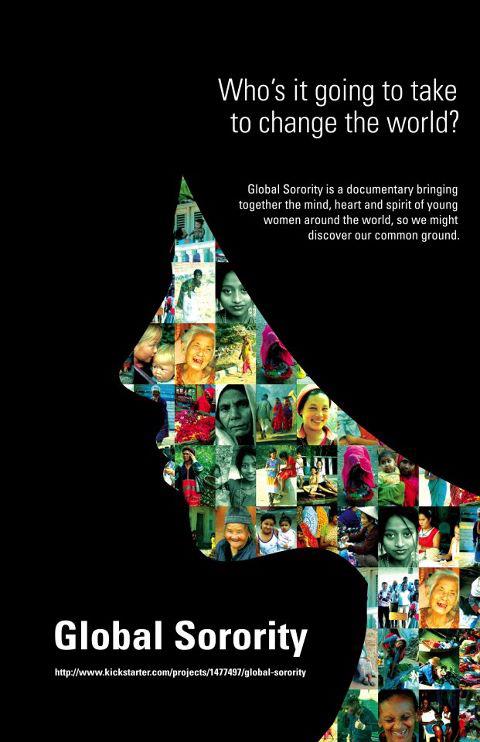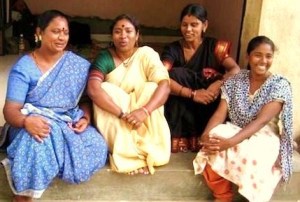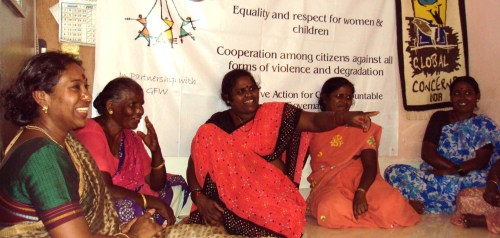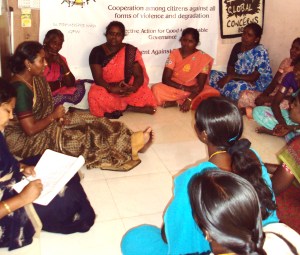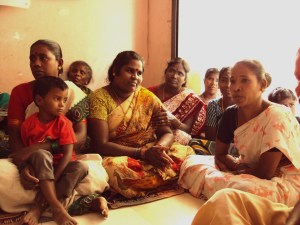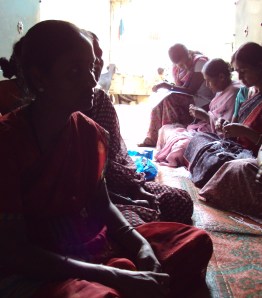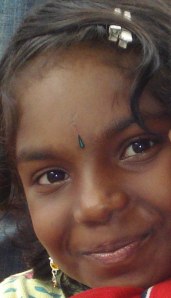Global Sorority
W’e’re excited to announce that we are coordinating with the Passion Foundation to create a leadership project for young girls and women (aged 11-24), most likely daughters or other younger female relatives and friends of the women currently participating in the dialogue project. The Passion Foundation will be in India for four days in December to work with Brinda to run these groups.
Filed under: Categories | Leave a Comment
feedback
These are some of the comments from the women who participated in the dialogues project:
“I like to come to this group because we talk about the things that are important to us, and we get to decide what we want to talk about.”
“When people ask me questions, they don’t expect anything intelligent to come out of me. Here, people ask me questions, and when I speak, they are willing to listen and want to listen. It is nice.”
“No one ever asked me how I felt when someone in my family asked me to do something I don’t want to do. The fact that I had to do that for our group homework, it just made me think a lot.”
“Because of the confidentiality, I am free to say whatever I want here, and no one calls me stupid or that I don’t have brains. I am not judged for what I think.”
“The confidentiality was really important. When I talk, it is almost like I’m gossiping, but I’m gossiping about myself.”
“I wondered, what is the point of this meeting, and was always thinking about my family and my children. But I realized there are things I can learn from listening to other women. Now I don’t worry about my family, I pay attention in the meetings.”
“I am happy to come to this meeting because I am able to speak freely, and I realized that although the women in this group put on a different face outside, we are all going through the same things.”
Filed under: Deliberative Dialogues Project, Other | Leave a Comment
translations
Working on the written translation of the research I had done on the social and labor challenges of domestic workers in India was more complicated than simply taking my English version and translating it into a comparable version of the local language. The primary audience, domestic workers, would mostly have no education or low-levels of education. Therefore, we wanted to create a DVD that would be accessible to those with low reading levels. However, we still thought it would be useful to create a written summary for women with higher levels of education, such as Standard 8-10. I know these women can be be very perceptive and sophisticated when it comes to understanding social concepts and dictates so it was difficult to figure out what aspects of the research to include and what to leave out. I wanted to keep the writing simple and accessible, and at the same time I didn’t want to omit relevant points that might help them to better understand the changing culture they found themselves in. For example, many of the domestic workers who participated in the research mentioned differences in the way they were treated by employers in extended, multi-generational families, versus the way they were treated by newly-emerging nuclear families in urban areas. I had quoted Qayum and Ray’s 2003 article, ‘Grappling with Modernity: India’s Respectable Classes and the Culture of Domestic Servitude’ but wondered whether the ideas were too complicated for this audience in a written form: Traditional concepts of servitude are conflicting with modern-day value systems and the idea that ‘servants’ are a necessary aspect of a household “sits uncomfortably with contemporary notions of privacy and ideologies of the nuclear family, especially in the more confined space of the apartment”.
To translate this properly, the translator would need to have an excellent grasp of English and then translate it, but also simplify the entire meaning in such a way that women who are not familiar with academic-level writing in their own language can understand it clearly.
I was lucky to have found Suma Anil of Fourth Wave Foundation, as she takes her role as translator very seriously. After she worked on an initial draft, she decided to arrange a meeting with some domestic workers who had higher levels of education to ask their opinions of the translation. They sat and listened as she read the research in its entirety, which took about thirty minutes, and asked them for their feedback. They felt the level of the translation was too “high” for them in some places, and that this was basically due to their lack of education. Now Suma has gone back to work not so much on the translation, but to re-write it in such a way that it retains the original meaning in a layman’s language. Without an accessible level of the local language, the translation would essentially be incomprehensible for the domestic workers who want to read this research, and all the work we put into it would be useless. Going through this process of translating even such a short document of six pages, I realize just how critical it is to get the right translator.
Filed under: Deliberative Dialogues Project, Other | Leave a Comment
habits
Sometimes this project can seem very complicated to explain to people, as it has so many moving parts. I would say that essentially, this program is about changing (negative) habits and using an agreed upon goal to practice more positive, useful responses. Brinda gave a very simple example to illustrate this concept. She said that many of these women have been taught that to be considered a ‘smart girl’ or a ‘smart woman’, they should always answer immediately when someone asks them something.
“Can you wash all these clothes for 100Rs?”
“Yes, of course, I will do it.”
It is only later when they have thought it through that they realize it will take a lot longer than the money is worth, and that they have agreed to something that they don’t feel comfortable with or that they don’t feel is fair. But because they have been taught they need to answer right away, they keep on repeating this habit and find themselves in situations they may not want to be in.
So we re-define ‘smart’. It is not smart to answer without thinking things through, and it is not smart to agree to something without fully understanding what you are getting yourself into. Instead, ‘smart’ means that you fully consider the consequences of what you are agreeing to before you reply, because then you will realize that you cannot wash that amount of clothes in the time you were expecting, and you will realize you are not comfortable with that salary. Then there is the practical application, how do you actually change the habit, what is the new response you will replace it with? When someone asks you if you agree to something, you thank them politely, and say let me think about it and I will get back you tomorrow.
Basically it is looking at habits and automatic responses that are not benefiting the women, becoming aware of the habit and the need to change it, and then replacing the habit with a response that better serves their needs. They then work together towards an objective and they are able to actively practice these new responses or ways of thinking in their lives, for a goal they have identified as important to them.
This example is very simplistic, but that is the foundation of what we are doing. However, many of the groups are tackling large issues that require them to shift ingrained modes of thinking and ways of doing things around gender roles, domestic violence, sexual harrasment and class differences. Another example would be the creation of group cohesion. Rather than attempting to address major social problems as isolated individuals, they are realizing they can turn to each other and use the power of the group to deal with issues. So they are breaking the habit or way of thinking that going it alone is the only option to address challenges. But to actually apply it to their lives, first they have to overcome many of the barriers to trusting and working with each other that have developed in these communities, and that is not an easy process. But as I mentioned before, with an experienced facilitator who is able to build trust, these women are beginning to understand they have a lot more power to change and direct their circumstances than they realized.
Filed under: Deliberative Dialogues Project, Other | Leave a Comment
In regards to measuring the outcomes, I have been worried about how time-consuming it was to get the women to respond to 30 multiple choice questions. One of my initial ideas was to have someone read off each of the questions, and then have the women check off the box (ie. strongly agree – strongly disagree which would be symbolized by smiley faces) themselves. Therefore, it wouldn’t take any reading or writing.
I know researchers often have trouble administering these types of questionnaires to particular groups, and I could clearly see why. I thought the questions were straightforward and easy to understand, and given the responses of the initial group when answering orally, the problem didn’t seem to be that the questions were too difficult or confusing. I thought I had by-passed the issue of literacy by having someone read out the questions to them, but as I saw the women glance at each other uncertainly, I knew I had mis-read the situation. During the deliberative dialogues, although they often seemed unsure of the format and hesitated before speaking up, when they finally decided to participate, they spoke with a lot of clarity and confidence. When they were asked to fill out the questionnaires, it was the first time I saw doubt and discomfort in their demeanor. In the end, they were just looking at each other’s sheets to see what the next person had checked off in order to figure out what the right answer was. I almost started laughing because the answers were obviously useless. Everyone had written down the same thing. We ended up using volunteers to sit down with each of the participants to fill out the sheets individually, but that method was simply not practical or sustainable.
However, an interesting thing has happened during this long, labor-intensive process. As the women have been able to have their questions fully answered – “Why do we need to check off these boxes, why don’t you just ask us?” “You have asked us if we would recommend these dialogues to our friends, but all the dialogues are filled up so no one else can join. So how could we recommend it?” – I’ve realized these kind of questionnaires are completely foreign to them, and it’s something they’ve never had to do. For example, they signed their names on the front of the sheet – I imagine for them, anything they have to sign is usually a signal of something serious, like a legal contract or government-related, so they were not sure what they were getting themselves into. But as the volunteers have patiently sat down with each of them, explained the questionnaire, explained how to answer in a multiple choice format, and answered all of their questions, we came to realize that the first time is the hardest. After they understand the context, they will be able to fill out the forms for themselves in the future. Once they sat down with the volunteers and were told what each of the multiple choice answers actually meant, almost all of them said, “That isn’t what I think, I want to change my answer.” The next time, they won’t need anyone to explain the purpose of the questionnaires or to help them to fill it out.
It was the entire concept, the idea and the format of the questionnaires, that was unfamiliar to them, not simply the literacy aspect of it. When they were able to ask all their questions fully, from what the 5-point scale meant to how the questionnaires would be used to improve the program, our biggest problem solved itself. Although further clarification of the scaling system may still be necessary and adjustments will still have to be made, the women have a much better understanding of the entire questionnaire process and we should be able to move forward without needing volunteers for each individual participant.
Filed under: Deliberative Dialogues Project, Designing the Program | Leave a Comment
measuring outcomes
Measuring the outcomes of the deliberative dialogues is an essential aspect of this project. How do we determine whether the dialogues have had any concrete benefit to these women, and if they have not, how do we tweak the program in order to create those benefits?
There are two parts to the dialogues:
1. issues and subjects, ie. budgeting, (wage) negotiation, domestic violence
2. objectives, ie. how she becomes empowered, how she understands control, how to assert and be independent (“do I respect myself”, “do I have control over the salary I earn”)
We decided to look at three aspects to be measured:
a. usefulness of the program
b. specific activities
c. ability to face life
For ‘usefulness of the program’, we used statements such as ‘I was able to understand the overall content of the dialogue’, ‘I will speak about this program to my friends and relatives’, and ‘I will strongly recommend people I know to attend a similar program’.
For ‘specific activities’, some statements we used were ‘I am open and frank about my feelings’, ‘I will suppress any disagreement or anger to safeguard my family prestige’, and ‘People often take advantage of me’.
For ‘ability to face life’, the statements were ‘I feel helpless and overwhelmed when faced with challenges’, ‘I have new solutions to address overwhelming situations’, etc.
With the first group, we ran a quick initial outcomes measurement where we asked the women to answer some of the questions. They were very forthright in answering them and had a lot to say. We wanted something more structured where we could have definitive measures of the outcomes, so I was eager to give them the written questionnaire.
However, the issue has become one of time. It simply took too long for volunteers to sit with each one of the women and read off the entire questionnaire to them. In addition, we would need to train the volunteers not to unduly influence the women’s answers. I had not fully realized what a time-consuming process it can be to fill out a simple questionnaire when your participants cannot read or write.
We are now looking at some alternatives. The first is to drastically reduce the number of questions so that the process can go more quickly. Another option is to run more of a focus group where the women can discuss whether the dialogues have been helpful to them, how it has been helpful to them, and how it could be improved to better meet their needs. But this may also be time-consuming. Finally, we could look at the specific goals each group has decided on, if the group has met the goal, and if not, what are the challenges to meeting this goal.
It will take a little more thought and discussion to figure out an accurate measure of the dialogues, but we have some viable options to explore.
Filed under: Deliberative Dialogues Project, Designing the Program | Leave a Comment
“Life is violence.”
Physical abuse is an epidemic in the communities these women come from. In some groups, 100% of the women may experience violence in their lives. But rather than being able to find support from each other, hierarchies are created out of these experiences, where the women who don’t experience violence often feel superior to those who do.
This has led Brinda to ask the question, “What does violence mean to you?”
The purpose of the question is to explore issues like verbal and emotional abuse, and that although some women may not experience violence, abuse is occurring in all of their lives. It is also an attempt to break down the hierarchy that is built up between women who are physically abused and those that are not.
Many of the women told stories of their abuse, almost matter-of-factly at times. It was heartbreaking to hear the social belief structures that underscored the abuse and made it seem normal and like an inevitable part of life. But I was most affected by one woman who had these very direct eyes. One of the coordinators was sitting beside me that day, translating as the women were talking. They were going around the room answering Brinda’s question.
This woman said, “Life is violence.”
She talked about how her husband was an alcoholic who didn’t contribute financially at all to the family, and who did nothing but sit around all day and watch television. She did not mention it directly, but most likely she was a victim of domestic violence, and had probably experienced abuse throughout the majority of her life. She wondered why women even continue to live except to take care of the children they brought into the world. “Otherwise, what is there to live for?” She did not break down, she said all of this with a very clear gaze, but you could see the pain behind her face.
This is what the deliberative dialogues are meant to be. I think any significant change in a person’s life begins with being able to sit with another person, or a group of people, and have the opportunity to speak their truth, to be able to say exactly what they are feeling and what is going on in their lives, personally, socially and politically.
All this pain had been building up inside this woman, and she had no one to speak to about it. There was nowhere to go to express her anger, she could only look around at her life and accept it. At this moment, she was able to say what was happening to her and express how it made her feel to a group she felt safe enough to confide in. As another women in the same group said, “I never talk about how I feel when I’m hurt, or what I go through when my family distrusts me.” In such a conservative culture, these are almost taboo areas.
The objective for the participants is to then strategize and become aware of how they can create confidence or courage within themselves, and then to see if they can express their confidence to others, and in their life. This means defining what confidence and assertiveness means to them in a concrete, realistic, and at times very modest, goal, and then actualizing it. They are then accountable to a supportive group that will work with her to make it happen. The challenges we are dealing with may be massive social issues like domestic violence, unfair labor laws and sexual harassment that we can’t swoop in and “solve” with a few workshops. However, we can build the capacity of the participants to learn more constructive and powerful ways to communicate and interact with each other as a group, to approach problems with new tools for exploring alternative methods of thinking and responding, and to formulate their own options and strategies.
Filed under: Deliberative Dialogues Project, Participant Interactions | Leave a Comment

